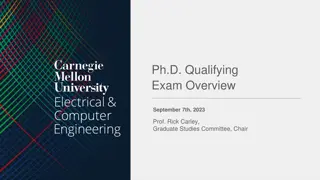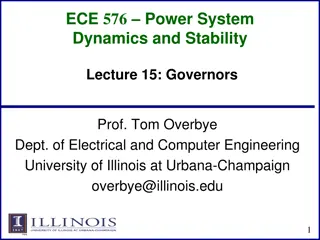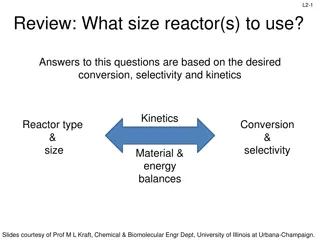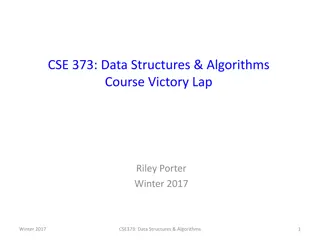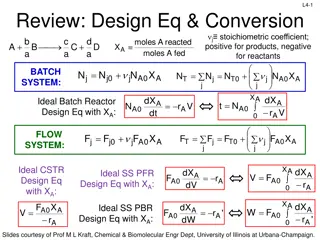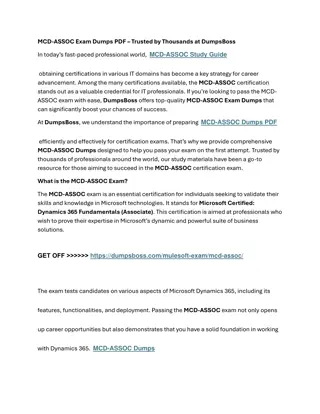Practice Exam 3 CS 418 at University of Illinois at Urbana-Champaign
This content covers topics such as the de Casteljau Algorithm, Bezier properties, Half-Edge Data Structure, and Euler Integration in interactive computer graphics. It includes examples, explanations, and visuals to aid in understanding these concepts for CS 418 students at the University of Illinois at Urbana-Champaign.
Uploaded on Feb 23, 2025 | 1 Views
Download Presentation

Please find below an Image/Link to download the presentation.
The content on the website is provided AS IS for your information and personal use only. It may not be sold, licensed, or shared on other websites without obtaining consent from the author.If you encounter any issues during the download, it is possible that the publisher has removed the file from their server.
You are allowed to download the files provided on this website for personal or commercial use, subject to the condition that they are used lawfully. All files are the property of their respective owners.
The content on the website is provided AS IS for your information and personal use only. It may not be sold, licensed, or shared on other websites without obtaining consent from the author.
E N D
Presentation Transcript
Practice Exam 3 CS 418: Interactive Computer Graphics UNIVERSITY OF ILLINOIS AT URBANA-CHAMPAIGN
The de Casteljau Algorithm b0=(-8,8), b1=(-4,-8), b2=(4,8), b3=(8,-8) Given 4 control points, generate position ?? ?0 lerp(t,a,b) = a*(1-t) + b*t ?0 ?1 ?1 ?0 ?0 ?0 ? 1 = lerp(t=.25, b0, b1) 1 = (-7,4) = (-8,8)*(1-.25)) + (-4,-8)*0.25 1 = lerp(t=.25, b1, b2) 1 = (-2,-4) = (-4,-8)*(1-.25)) + (4,8)*0.25 2 = lerp(t=.25, ?0 2 = (-7,4)*(1-.25)) + (-2,-4)*0.25 2 = (-7*(3/4) + -2*(1/4), 4*.75 + -4*.25) => ((-23/4), 2) ,?1 1) 1
Bezier properties Suppose you have a 2D Bezier curve defined by the control points b0, b1, and b2. Which of the follow is NOT true of that curve? Changing the order to b2, b1,b0, wouldn t change the points which the curve goes through, nor the midpoint, so, true. Bezier curves always pass through the first and last points, so, definitely true. It is indeed bounded by the control points, true 3 Points defines a quadratic, so, definitely not true
Half Edge Data Structure 1 Finding the four vertices found in O(1) How? V_s = e.opp->end; V_t = e.end; V_l = e.next->end; V_r = e.opp->next->end; Half Edge Data Structure 1
Euler Integration Suppose Euler integration is used to generate particle positions in a simple Newtonian physics particle simulation. Which of the following would be associated with larger error in the computed positions? Important Concept: Euler Integration determines total distance by adding up time intervals with constant velocity. The (incorrect) assumption is that the acceleration only changes the velocity when one of these time intervals ends
Euler Integration A larger timestep This is true because larger time steps mean the particle will be assumed to move at a constant velocity for a longer time, thus incurring more error in distance calculated from the incorrect assumption A smaller timestep This is not true (opposite of above) Particles with larger acceleration This is true because larger accelerations mean the particle s velocity should have changed more during the time step (but it is assumed constant) Both a smaller timestep and larger acceleration No, because the smaller time step was not true Both larger acceleration particles and a larger timestep This is the final answer (both components are true)
Euler Angles Changing the order of rotation can affect the result. True Consider a die, flip and rotate Flip left face up get 2, rotate about Y still 2 Rotate about Y get bottom image Flip left face up get 3
Euler Angles An Euler angle representation of an orientation uses less data than a quaternion representation. True Euler is three angles, 3 vec, Quat is a 4 element vector Any orientation expressed as a quaternion can be expressed using Euler angles. True While sequences of rotations are subject to gimbal lock, any static orientation can be represented with Euler or Quat
Euler Angles The three axes used for the Euler angle representation must be unique. For example, using the X axis, then the Y axis and then the X axis would not work. False There are six possibilities of choosing the rotation axes for proper Euler angles. In all of them, the first and third rotation axes are the same. Note, the last axis has been modified by the first and second rotation potentially
Catmull-Clark Subdvision Polygon Counts 1 Suppose we start with a cube modeled by a mesh of 6 quadrilaterals. Catmull-Clark subdivision applirf subdivision to the entire mesh 3 times, how many quads? Starting with one quad, quadrupling N times yields, 4^N, How many faces did we start with, say M. M * (4 ^ N) 6*(4^3) = 6 * 64 = 384
Quaternions Which of the following is NOT true of quaternions? Concatenating two rotations represented as quaternions requires a single quaternion multiplication. Definitely true (review literature, a little complicated of a proof). Transforming a point with a quaternion requires 2 quaternion multiplications. True, the equation, p=q vq, (where q* is the conjugate quaternion) is used to transform a point or vector, so there are two multiplies. Any 3D rotation matrix can be represented by a quaternion. Definitely true, there is a general conversion operator. A single quaternion can describe a rotation around any of the X, Y, or Z axes but not around an arbitrary axis. Definitely not true, a matrix can, and thus a quaternion can.




